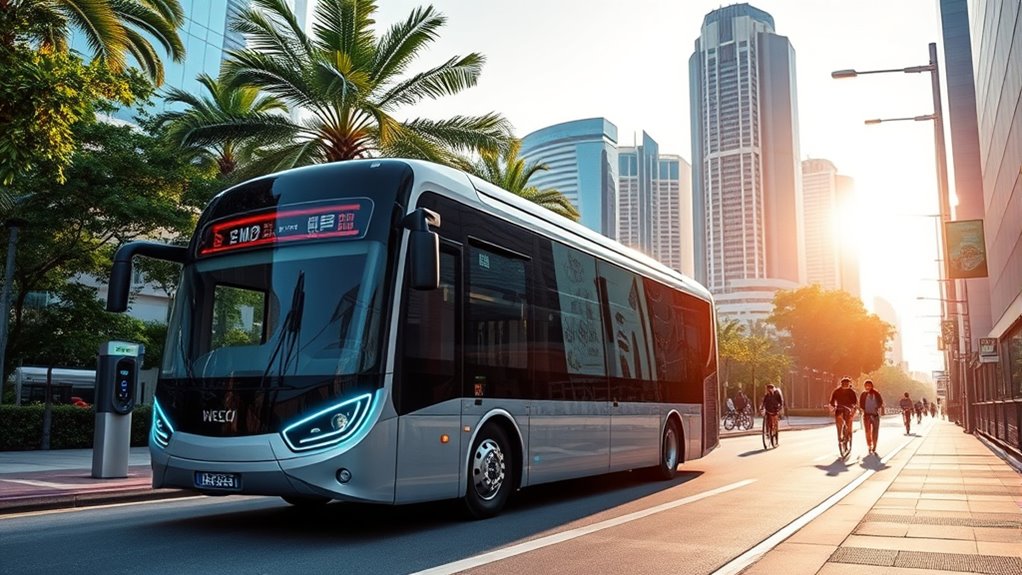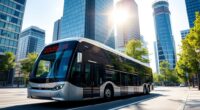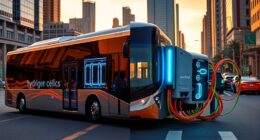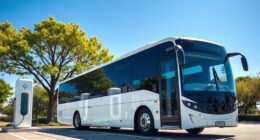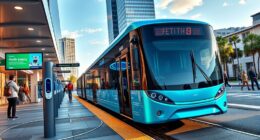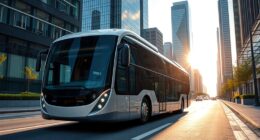Singapore is leading the way in electric bus adoption with bold goals to have 50% of its fleet electric by 2030 and fully shift by 2040. The government invests heavily in infrastructure, expanding charging networks and building eco-friendly depots. Public-private partnerships and incentives lower costs, while a growing electric bus fleet supports cleaner urban transport. If you look further, you’ll discover how Singapore’s strategies make it a regional pioneer in sustainable mobility.
Key Takeaways
- Singapore plans to have 50% of its bus fleet electric by 2030 and complete transition by 2040.
- The government invests heavily in charging infrastructure, including high-power chargers and depot upgrades.
- Strategic partnerships and incentives support private sector adoption and reduce electric bus costs.
- Singapore’s sustainable urban planning integrates green depots and renewable energy to support electric buses.
- Ambitious policies and regional leadership position Singapore as a pioneer in electric bus adoption in Asia.
Singapore’s Ambitious Electric Bus Targets for 2030
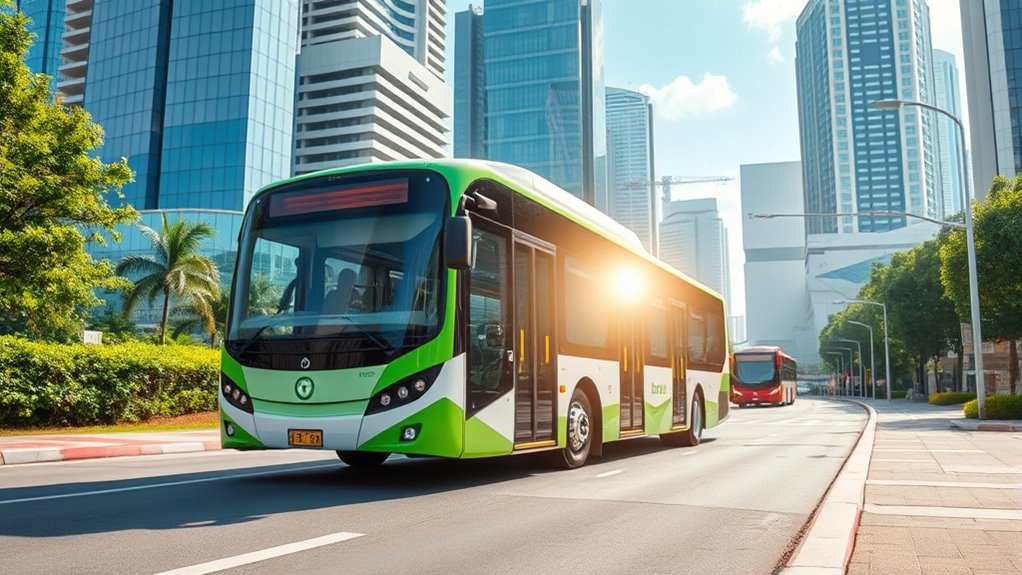
Singapore aims to transform its public bus fleet by 2030, setting an ambitious goal to achieve 50% electrification. This means that half of the 3,000 buses on the road will run on cleaner energy, with the full shift to electric buses planned by 2040.
To reach this target, over 2,000 electric buses will be procured within the next five years, including double-deck models suited for urban routes. The city-state is also phasing out more than 400 diesel buses, replacing them as they reach end-of-life, mainly by 2025. Cost considerations are being carefully managed to ensure the widespread adoption of electric buses remains feasible and sustainable. Additionally, the adoption of advanced charging infrastructure is vital for supporting the increased electric fleet and ensuring operational efficiency.
Infrastructure development is underway, with new depots being commissioned to support the expanded electric fleet. These efforts are aligned with Singapore’s Green Plan 2030 and Land Transport Master Plan 2040, driving sustainable urban mobility. Additionally, the government is exploring innovative funding mechanisms to support electric bus adoption and ensure long-term viability. The integration of low-emission transportation strategies further enhances Singapore’s leadership in sustainable urban transit.
Current Electric Bus Fleet and Future Expansion Plans
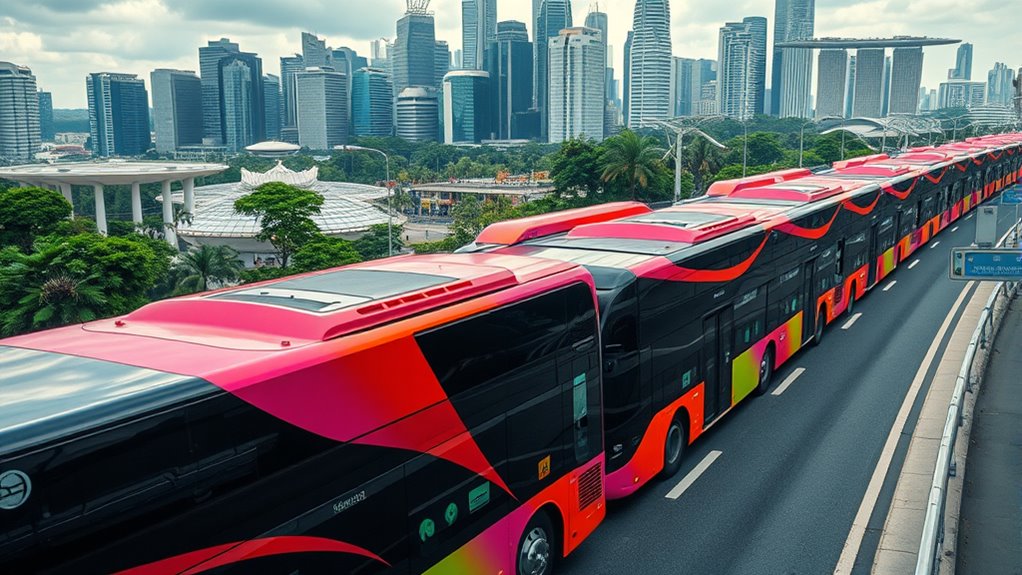
The current electric bus fleet in Singapore showcases a mix of models and configurations that support the city-state’s sustainability goals. You’ll find models like Zhongtong LCK6126EVG and BYD BC12A04, recently added to the fleet, operated by SBS Transit and SMRT Buses.
The fleet includes single-deck, double-decker, and articulated buses like the MAN NG363F, serving routes such as 86, 107, and 159.
In 2024, Singapore introduced 360 new electric buses, with a $166.4 million contract reflecting strong investment. These recent additions help expand the fleet and incorporate advanced technology.
Looking ahead, a tender for 660 more buses—split between single-deck and double-decker models—aims to more than double the fleet by 2027, further enhancing public transportation and environmental benefits. Renewable energy advancements and sustainable transportation initiatives continue to play a pivotal role in Singapore’s efforts to reduce carbon emissions and promote eco-friendly urban mobility. Additionally, ongoing improvements in energy-efficient systems ensure that the buses operate with lower energy consumption and emissions, aligning with the country’s green objectives.
Major Initiatives Supporting Electric Bus Deployment
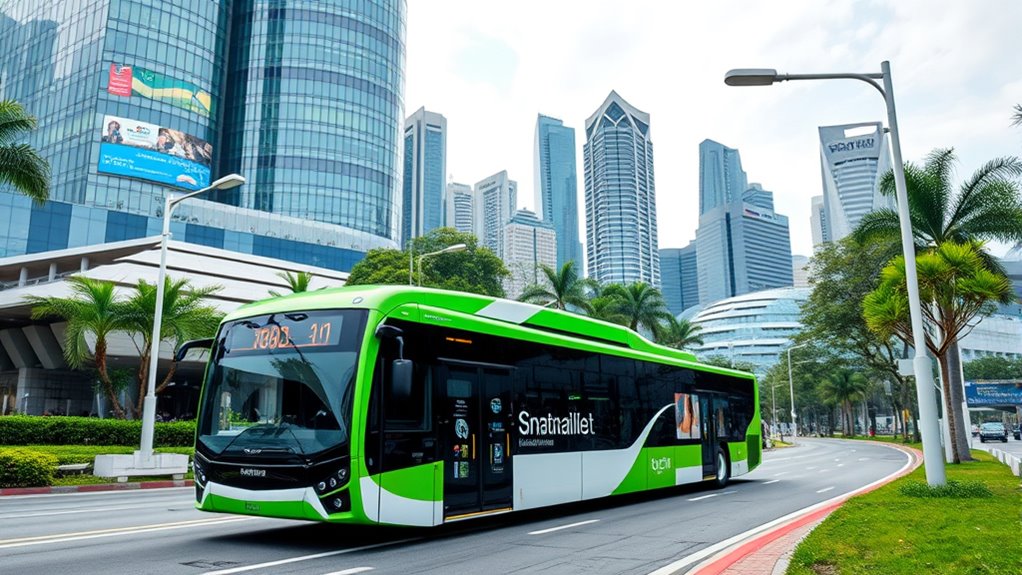
Government incentives play a crucial role in supporting the deployment of electric buses by making them more affordable and attractive to operators. The Singapore government encourages EV adoption through various incentives, including vehicle tax policies under the Green Plan 2030, which promotes cleaner transportation.
Industry partnerships, like those with ABS Group, help lower costs and increase accessibility. Technological innovations, such as regenerative braking, improve energy efficiency and operational performance.
These initiatives align with Singapore’s environmental goals, aiming for a 100% cleaner energy bus fleet by 2040. Legislative frameworks provide the necessary support, with standards ensuring safety and efficiency.
Public awareness campaigns and demonstration projects educate citizens and build confidence in electric buses, further accelerating their adoption.
Infrastructure Development and Charging Network Expansion
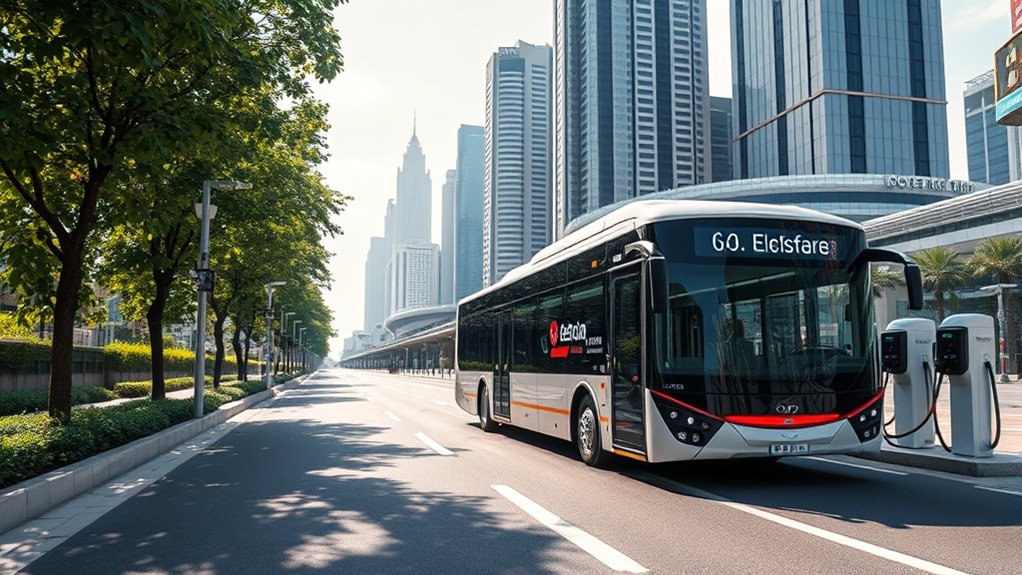
To support the rapid adoption of electric buses, significant infrastructure development and expansion of the charging network are underway.
Singapore is expanding its electric bus infrastructure to meet growing demand efficiently.
Sengkang West bus depot, the first multi-storey electric bus depot, features green roofs, solar panels, rainwater recycling, and has earned the BCA’s Green Mark Platinum certification. It will operate early 2025, supporting the growing fleet.
Other depots like East Coast and Gali Batu are also being upgraded with electric vehicle charging systems and serve as transport hubs.
The charging network includes high-power chargers—up to 360kW—at Sengkang West, enabling buses to recharge in under 1.5 hours, and overhead pantograph chargers rated up to 450kW, taking about 30 minutes.
This expansion guarantees efficient, fast, and reliable charging to meet the increasing demand for electric buses across Singapore.
Overcoming Challenges and Setbacks in Electrification
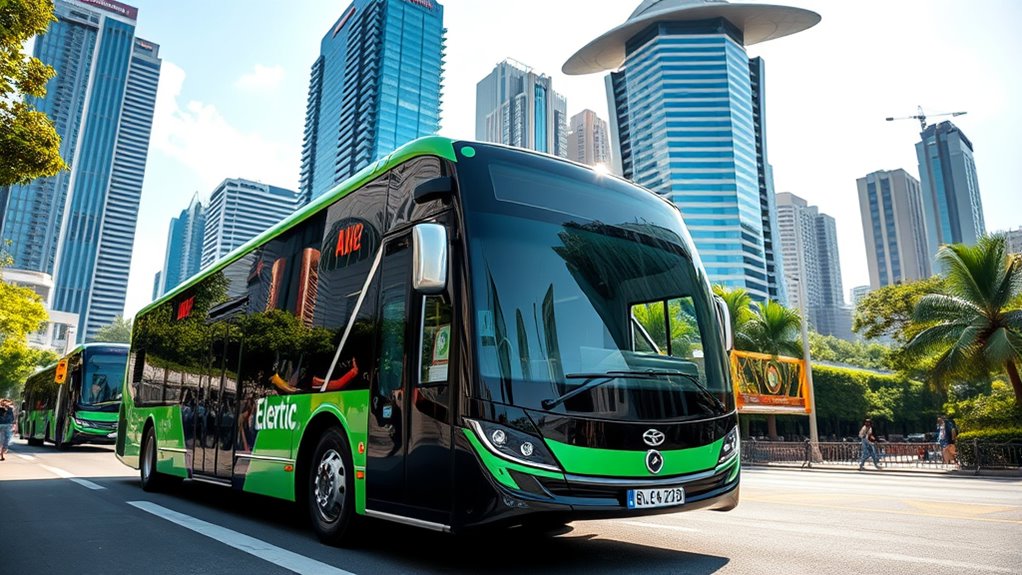
Despite the promising benefits of electric buses, several technological, financial, and regulatory hurdles challenge their widespread adoption in Singapore.
Technologically, limited bus models fit Singapore’s dense urban environment, and high battery costs and durability issues affect operational efficiency. Slow charging times and concerns over vehicle lifespan also pose challenges. Additionally, advancements in wig styling technology could further facilitate the integration of new features into electric buses, enhancing their appeal and functionality. Recognizing the importance of vibrational energy in the Law of Attraction, continuous innovation and positive mindset are essential for overcoming these barriers. Incorporating advanced battery technology can improve performance and extend lifespan, making electric buses more viable in demanding urban settings. Moreover, ongoing research in electric vehicle infrastructure is crucial to support the growth of electric bus fleets across the city.
Financially, the higher purchase prices and maintenance costs for specialized parts strain budgets, relying heavily on government incentives. Scaling up purchases to reduce costs requires substantial upfront investment, and predicting long-term savings remains uncertain.
Regulatory hurdles include the need for clear policies, standards, and industry collaboration to ensure safety and efficiency.
Overcoming these barriers demands coordinated efforts, innovation, and persistent adaptation to foster a smoother progression to electric buses across Singapore.
Environmental Benefits and Sustainability Goals
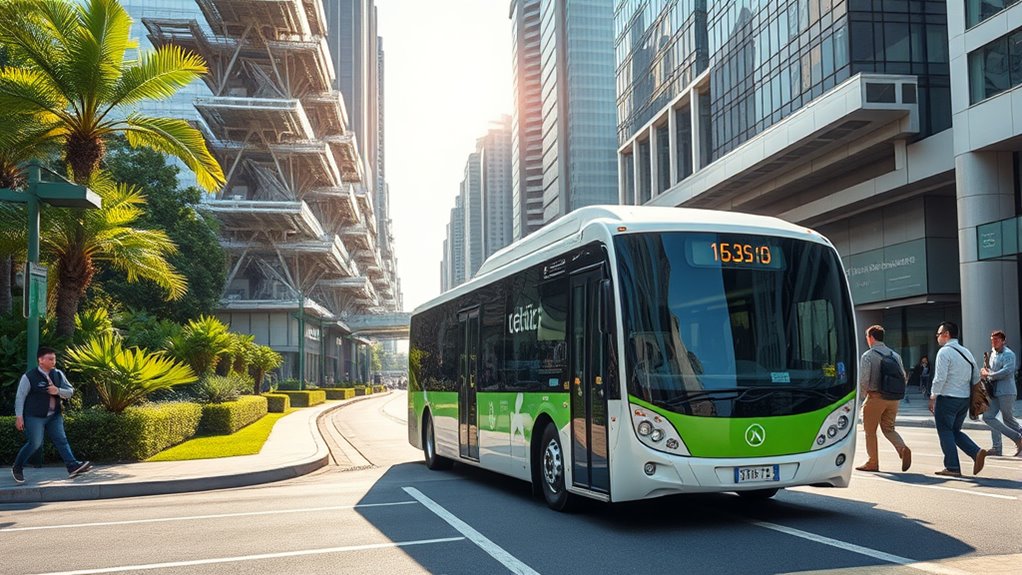
Electric buses play a crucial role in Singapore’s vision for a sustainable future, as their zero-tailpipe emissions directly improve urban air quality. By replacing diesel buses, you reduce greenhouse gas emissions, supporting the nation’s carbon reduction targets.
You’ll also notice less noise pollution thanks to quieter electric operations, making the city more livable. This shift decreases reliance on fossil fuels, aligning with Singapore’s energy diversification strategies.
The country’s plan to have a 100% cleaner energy bus fleet by 2040, including electric and hydrogen buses, further accelerates this effort. With 50% of public buses electrified by 2030 and new charging infrastructure, you’re part of a movement toward long-term sustainability.
The goal is to cut emissions, improve urban health, and position Singapore as a regional leader in green transportation.
Public Support and Growing Awareness of Electric Vehicles
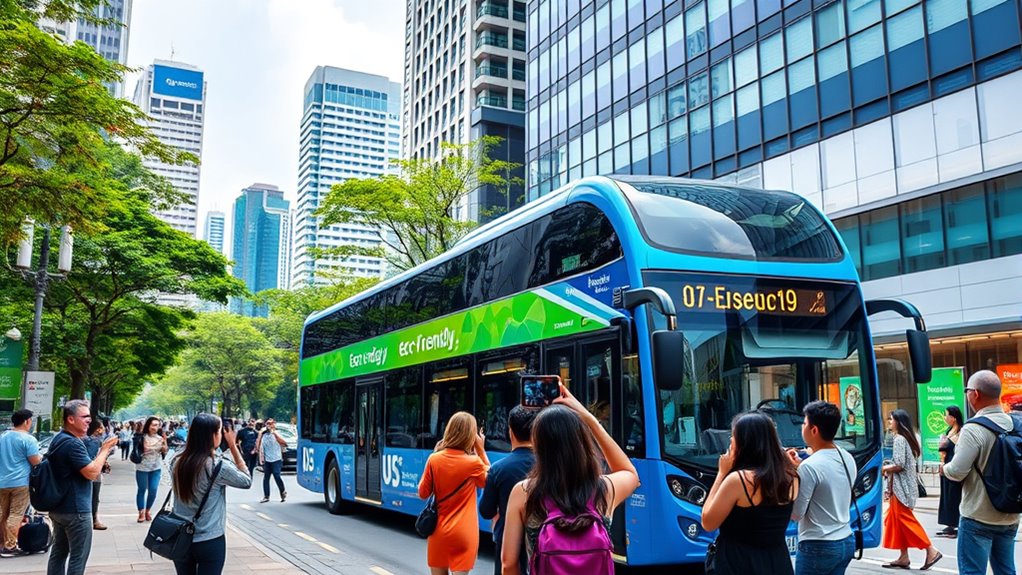
Have you noticed how public awareness about electric vehicles (EVs) is growing in Singapore? The Land Transport Authority (LTA) has launched campaigns to highlight EV benefits for owners and the environment. They promote standardization of charging stations, making it easier for drivers to recognize and use them.
Public awareness of EVs in Singapore is growing, supported by campaigns and standardized charging stations.
Collaboration between the government and private sector helps educate the public and encourages EV adoption. Efforts to promote mass public transport also support this shift. Many initiatives focus on infrastructure improvements, such as increasing the number of charging stations and self watering plant pots, which can serve as an analogy for efficient resource management in sustainable transport systems.
Additionally, hosting or participating in Hackathons related to EV technology can accelerate innovation and develop practical solutions to common challenges in sustainable transportation. As a result, more people are recognizing the advantages of EVs, boosted by financial incentives that make purchasing easier. This growing awareness is fostering a cultural change toward sustainable transport. Understanding yarn for scarves and other sustainable practices can also inspire innovative solutions in eco-friendly transportation.
With continued campaigns and infrastructure development, Singapore is building a strong foundation for widespread EV adoption, including electric buses. *Awareness of grocery store hours* can also play a role in supporting the logistics and planning needed for expanding sustainable transportation infrastructure.
Policy Framework and Funding Incentives

Singapore’s efforts to promote electric bus adoption are supported by an all-encompassing policy framework and targeted funding incentives. The Ministry of Transport’s policies aim to reduce costs for electric vehicles, while the Land Transport Authority targets a 100% cleaner energy bus fleet by 2040 and plans to electrify half of it by 2030.
The Green Plan 2030 commits to expanding electric buses as part of Singapore’s environmental goals. The government offers tax incentives to lower purchase costs and invests heavily in infrastructure, including charging stations and depot upgrades. Cultural intelligence can play a role in fostering stakeholder engagement and ensuring effective communication across diverse communities involved in transportation initiatives.
Stricter emission standards, such as Euro VI for diesel buses, push operators toward cleaner options. Clear targets and regulations create a favorable environment for investment, making electric buses a central part of Singapore’s sustainable transport vision. Additionally, understanding signs of spoilage in related contexts helps ensure the maintenance and longevity of new electric bus fleets. Furthermore, ongoing research into innovative battery technologies supports the development of more efficient and sustainable electric bus systems. Incorporating advanced energy storage solutions can further enhance the performance and reliability of electric buses in Singapore’s transit network.
Private Sector Involvement in Electric Bus Operations
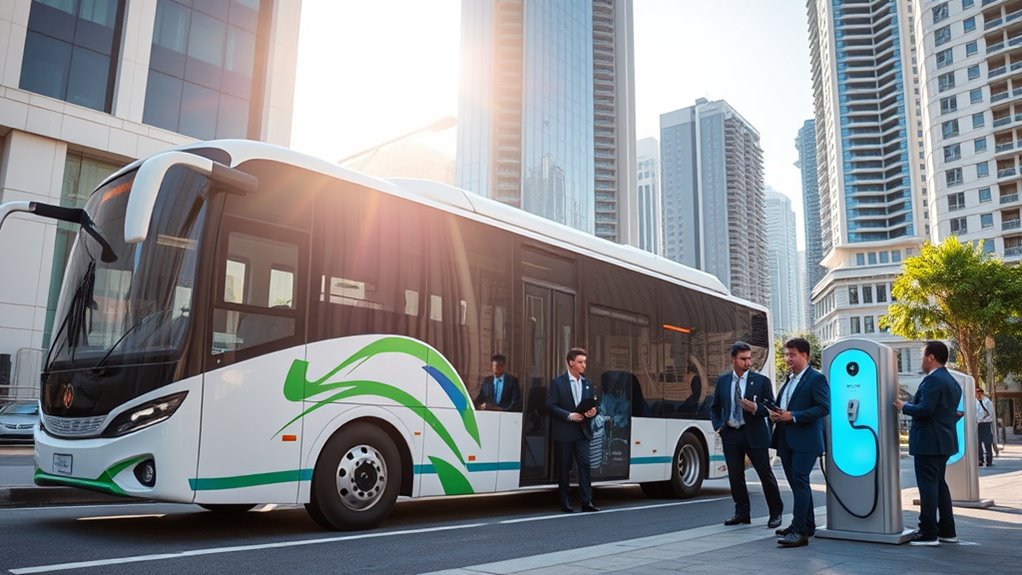
Private companies play an essential role in advancing Singapore’s electric bus landscape by actively expanding their fleets and integrating innovative technologies. ComfortDelGro leads with the largest private electric bus fleet, operating 8 routes since 2022 that serve campuses like Kent Ridge and Bukit Timah, with features like telematics, collision warnings, and wheelchair accessibility. Their focus on sustainability aligns with national goals. Meanwhile, procurement contracts with Zhongtong and BYD, totaling over 360 buses, demonstrate private sector investment in large-scale electrification, supported by depot-based charging infrastructure. These efforts emphasize long-term savings despite higher initial costs. Private fleets also use real-time monitoring and safety systems, contributing to industry-wide standards. Their active participation exemplifies how private companies are shaping Singapore’s shift toward zero-emission mobility, especially through wall organization systems that enhance operational efficiency and safety. Additionally, the adoption of electric bus technology is driven by private sector innovation and commitment to sustainable transportation solutions. The integration of sustainable transportation initiatives by private firms further accelerates nationwide environmental targets. Furthermore, private operators are exploring energy storage solutions to optimize charging and reduce operational costs.
Singapore’s Role as a Leader in Sustainable Urban Transport

Despite facing infrastructure challenges, Singapore has established itself as a regional leader in sustainable urban transport by setting ambitious government targets and implementing extensive policies.
The nation aims for a 100% cleaner energy public bus fleet by 2040, with half of all buses electric by 2030, and plans to deploy 60,000 EV charging points by 2030. Singapore’s goal to have 80% of passenger vehicles electric by 2040 surpasses regional averages, showcasing its commitment to decarbonization.
Although electric bus deployment remains limited—67 buses as of 2022—broader electrification momentum is evident in rising EV sales. Policies like rebates and grants, along with public-private partnerships, support this progression.
Infrastructure gaps and cost barriers pose hurdles, but Singapore’s strategic approach positions it as a leader shaping regional sustainable urban transport.
Frequently Asked Questions
How Will Singapore Ensure Sufficient Charging Infrastructure for Increased Electric Bus Numbers?
You see, Singapore plans to guarantee enough charging stations by prioritizing new depots like Sengkang West, Gali Batu, and East Coast. They are installing high-power chargers and using scalable, modular designs.
They’re also partnering with suppliers and integrating smart technology for real-time monitoring. This approach allows flexible expansion, maximizes uptime, and guarantees your electric buses stay charged as fleet numbers grow toward their 2030 and 2040 targets.
What Are the Specific Challenges Faced by Private Operators in Adopting Electric Buses?
Like steering a maze, private operators face many hurdles adopting electric buses. You deal with high upfront costs, making it tough to justify investment. Charging infrastructure is limited, causing route disruptions.
Upgrading depots costs time and money, while battery life adds ongoing expenses. Regulatory uncertainties and market competition also hold you back.
Overcoming these challenges requires supportive policies, better infrastructure, and technological advancements to make electric buses more accessible and affordable.
How Does the Cost of Electric Buses Compare to Traditional Diesel Buses?
You’ll notice that electric buses cost about 50% more upfront than diesel buses, with a typical price around $887,308 compared to $480,000 for diesel.
However, you save considerably on operating costs—electricity is roughly 2.5 times cheaper than diesel—and maintenance is reduced.
Over a 12-year lifespan, electric buses can save you between $73,000 and $173,000, making them more economical in the long run.
What Measures Are in Place to Maintain Electric Buses in Singapore’S Fleet?
You’d think maintaining electric buses is a nightmare, but Singapore’s got it covered. They’ve partnered with Stratio for real-time predictive maintenance, catching issues early before they become disasters.
With fewer parts to service, warranties up to 8 years, and staff trained in high-voltage safety, the fleet stays in top shape.
Charging stations expand, and proactive depot upgrades keep everything running smoothly—no surprise breakdowns, just efficient, clean transit.
How Will Electric Bus Deployment Impact Singapore’S Overall Transportation Costs?
You’ll find that deploying electric buses in Singapore lowers overall transportation costs over time. Although the initial investments in infrastructure and vehicles are significant, electric buses reduce fuel and maintenance expenses, yielding long-term savings.
Plus, government incentives ease the upfront costs. These factors combine to make electric buses a cost-effective choice, improving operational efficiency and helping you save money while supporting cleaner, greener transportation for everyone.
Conclusion
You can see Singapore’s leadership in electric bus adoption through its goal to have all public buses run on cleaner energy by 2030. With over 1,000 electric buses already on the roads and plans to expand further, the city-state’s commitment is clear. This proactive approach not only reduces emissions but also positions Singapore as a global pioneer in sustainable urban transport, inspiring other cities worldwide to follow suit.
